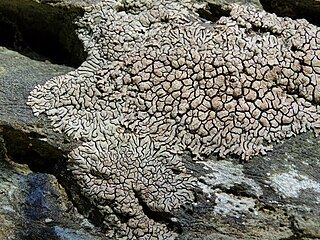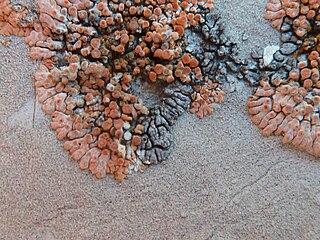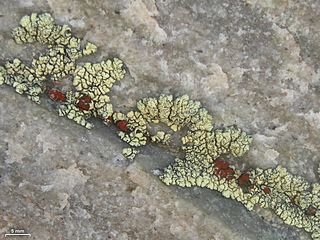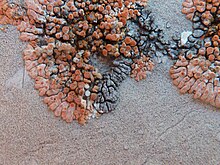
Verrucariaceae is a family of lichens and a few non-lichenised fungi in the order Verrucariales. The lichens have a wide variety of thallus forms, from crustose (crust-like) to foliose (bushy) and squamulose (scaly). Most of them grow on land, some in freshwater and a few in the sea. Many are free-living but there are some species that are parasites on other lichens, while one marine species always lives together with a leafy green alga.
The Adelococcaceae are a family of fungi in the order Verrucariales. Species are mostly found in north temperate regions, and are biotrophic or necrotrophic on lichens. The family was proposed by mycologist Dagmar Triebel in 1993.
Clauzadella is a genus of fungi in the family Verrucariaceae. A monotypic genus, it contains the single species Clauzadella gordensis, discovered in France and described as new to science in 1996 by Pere Navarro-Rosinés and Claude Roux.
Bellemerella is a genus of fungi in the family Verrucariaceae. All four species are lichenicolous, meaning they grow parasitically on other lichens.

Placopyrenium is a genus of saxicolous (rock-dwelling), crustose lichens in the family Verrucariaceae.
Sarcopyrenia is a genus of lichenicolous (lichen-dwelling) fungi. It has 11 species. It is the only genus in Sarcopyreniaceae, a family in the order Verrucariales. Sarcopyrenia was circumscribed by Finnish lichenologist William Nylander in 1858, with Sarcopyrenia gibba assigned as the type species. Sarcopyreniaceae is one of the few families composed entirely of lichenicolous fungi.

Hydropunctaria is a genus of saxicolous (rock-dwelling), crustose lichens in the family Verrucariaceae. The genus includes both aquatic and amphibious species, with members that colonise either marine or freshwater habitats. The type species, Hydropunctaria maura, was formerly classified in the large genus Verrucaria. It is a widely distributed species common to littoral zones. Including the type species, five Hydropunctaria lichens are considered marine species: H. adriatica, H. amphibia, H. aractina, H. orae, and H. oceanica.

Verrucula is a genus of lichenicolous (lichen-dwelling) lichens in the family Verrucariaceae. Species in the genus are parasitic on saxicolous (rock-dwelling), crustose lichens, including Xanthoria elegans as well as lichens from genus Caloplaca that contain chemical substances called anthraquinones.

Verruculopsis is a genus of saxicolous (rock-dwelling), crustose lichens in the family Verrucariaceae. It was circumscribed in 2007 by Cécile Gueidan, Pere Navarro-Rosinés, and Claude Roux, with Verruculopsis poeltiana assigned as the type species.
Halospora is a genus of lichenicolous (lichen-dwelling) fungi in the family Verrucariaceae. Species in the genus parasitise calcicolous crustose lichens, i.e., those that prefer lime-rich substrates.

Ochrolechia upsaliensis is a species of crustose lichen in the family Ochrolechiaceae. Found in the Northern Hemisphere, it is commonly known as the tundra saucer lichen.

Solorina crocea, commonly known as the orange chocolate chip lichen, is a species of terricolous (ground-dwelling) and foliose (leafy) lichen in the family Peltigeraceae. The lichen, which was first formally described by Carl Linnaeus in 1753, has an arctic–alpine and circumpolar distribution and occurs in Asia, Europe, North America, and New Zealand. It generally grows on the bare ground in sandy soils, often in moist soil near snow patches or seepage areas. Although several forms and varieties of the lichen have been proposed in its history, these are not considered to have any independent taxonomic significance.

Pier Luigi Nimis is a senior professor of botany at the University of Trieste in Italy. He specialises in lichenology and phytogeography, including the uses of lichens as indicators of pollution and devising methods for web-based identification keys.
Trimmatothele is a genus of saxicolous (rock-dwelling), crustose lichens in the family Verrucariaceae. It has five species. The genus was formally published by lichenologist Alexander Zahlbruckner in 1903. The type species, Trimmatothele perquisita, was originally collected from Norway by Johannes M. Norman, who placed it in the genus Coniothele in 1868. Diagnostic characteristics of Trimmatothele include a thin thallus with a smooth surface; small perithecia that are partially immersed in the substrata and have an involucrellum; asci that contain multiple ascospores; and small, simple ascospores. Trimmatothele has been described as one of the most poorly known genera of lichens due to the rarity of its species, the few available herbarium specimens, and some missing type specimens.
Maronella is a genus of lichens of uncertain familial and ordinal placement in the class Lecanoromycetes. The genus was circumscribed in 1959 by German lichenologist and lichen chemist Maximilian Steiner with Maronella laricina assigned as the type, and at that time, only species. This lichen is rare, having only been recorded from Austria and Spain. M. coreana, known only from type collection in South Korea, was added to the genus in 2015. Both species grow on bark and have a crust-like thallus.
Stigmidium cerinae is a species of lichenicolous (lichen-dwelling) fungus in the family Mycosphaerellaceae. It was formally described as a new species in 1994 by mycologists Claude Roux and Dagmar Triebel. The type specimen was collected in Austria from the apothecia of the muscicolous (moss-dwelling) species Caloplaca stillicidiorum. It infects lichens in the genus Caloplaca, and more generally, members of the family Teloschistaceae. Infection by the fungus results in bleaching of the host hymenium.

Erichansenia epithallina is a species of saxicolous (rock-dwelling), crustose lichen in the family Teloschistaceae. It is also a lichenicolous lichen species, meaning that it grows on other lichens. Many host genera have been recorded. It occurs in Europe and North America, including Arctic regions.

Flavoplaca maritima is a species of crustose lichen in the family Teloschistaceae. It is found in costal areas of Northern, Western, and Southern Europe. It mostly occurs on rocks, but has also been recorded growing on wood.
Caloplaca rinodinae-albae is a lichenicolous (lichen-dwelling) species of crustose lichen in the family Teloschistaceae, first described in 1987. This species is unique for its parasitic growth on the lichen Helmutiopsis alba. Characteristics of the lichen include its small, rounded, pale orange thalli and its ability to form larger patches through the confluence of individual thalli.

Hydropunctaria amphibia is a species of saxicolous (rock-dwelling), crustose lichen in the family Verrucariaceae. One of several marine lichens in the genus Hydropunctaria, is widely distributed across Europe, extending from Norway to the Mediterranean and the Iberian coasts, and has a nearly ubiquitous presence along the Catalan coast of Spain. In North America, it is found along the Atlantic Coast from Nova Scotia to the Boston Harbor islands, where its presence in low-pollution areas indicates its potential as a bioindicator for marine lichen community health, and on the west coast in British Columbia, particularly in the Gwaii Haanas's upper littoral fringe. The black, crust-like thallus grows on seashore rocks – both siliceous rocks and limestone – in the lower supralittoral zone, an area also known as the splash zone. Originally described more than two centuries ago as a species of Verrucaria, Hydropunctaria amphibia sets itself apart from other species in Hydropunctaria through the distinct shape of the perithecium apex, which is either flat-topped or scalloped, in contrast to the typically rounded or immersed apex seen in its relatives.











